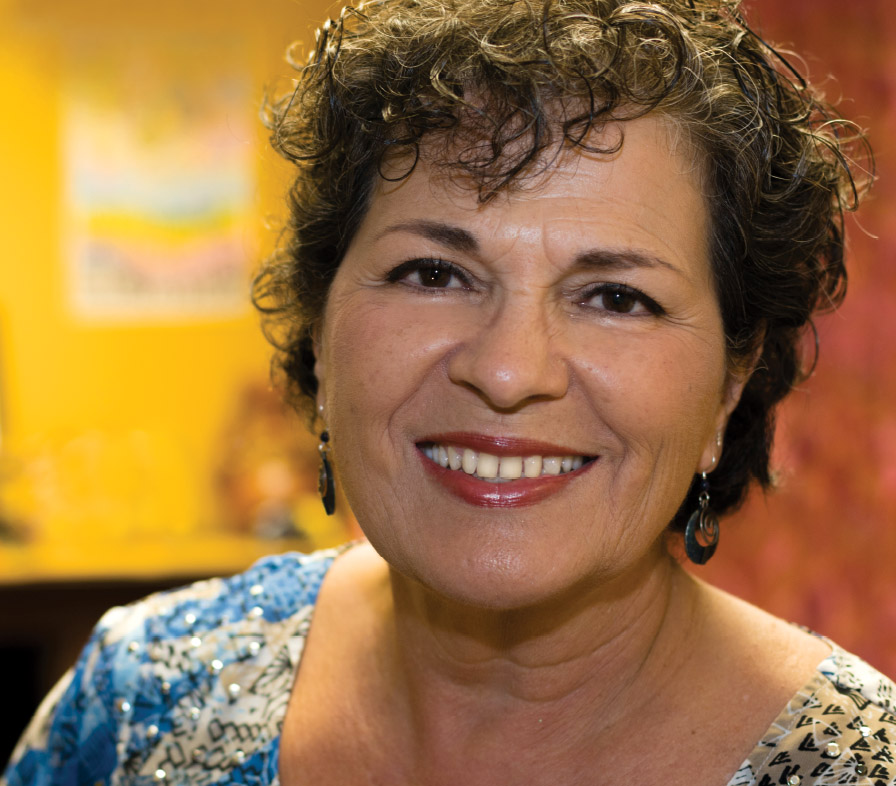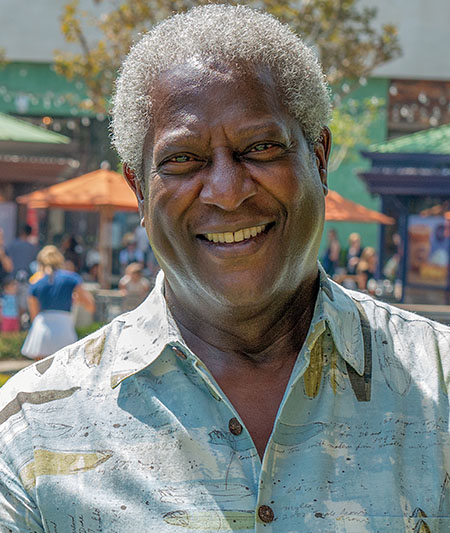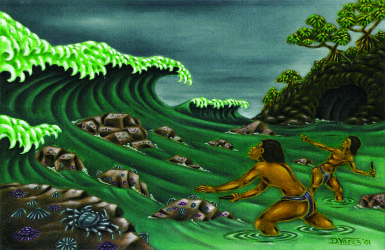
Dietrich Varez: A Malihini’s Legacy of Illuminating Hawaiian Culture and Legend
By Paula Thomas
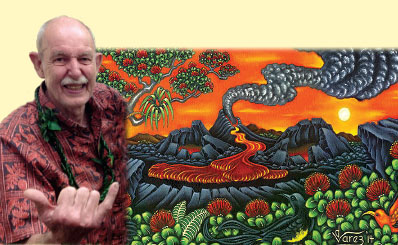 He makes his art to give back to his beloved Hawai‘i.
He makes his art to give back to his beloved Hawai‘i.
He never set out to make a lot of money as an artist, however it worked out that art became his livelihood. He remains overjoyed this has kept him busy for nearly 50 years.
Dietrich Varez’s hands have carved some 220 blocks of linoleum, from which he has printed hundreds of thousands of block prints. These have made their way into homes, offices, and personal collections all across the globe. It delights him, though not egotistically, that his depictions have disseminated Hawaiian culture and legend throughout the world.
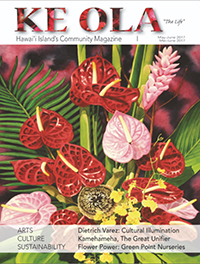
What he realized when he moved to Hawai‘i Island and started working inside Hawai‘i Volcanoes National Park, was that everyone wanted to know about the fire goddess Pele, Kamapua‘a the pig god, moon goddess Hina, trickster Māui, the legend of Lehua and ‘Ōhi‘a, and more.
He served as caretaker of the Nāmakanipaio Cabins, hired by Nick Lykurgus, son of Volcano House owner “Uncle George.” He also lived there with his wife until he built his house. This was in the 1970s. He also tended bar at Volcano House where he had a clear view of Pele’s lava fields and the smoking Halema‘uma‘u Crater.
To Dietrich, there was no better classroom. “I got to know all the terrain,” he says, “every berry, every bush. I had to talk about Pele every day. Visitors asked a lot of questions. I learned all the stories from the people around me so I could answer.”
His work as an artist arose from a kind of emergency awareness, which was the realization that no images of these stories existed anywhere. He decided to do something about it. “A story sinks more into people’s brains if you depict it,” says this former English major with graduate training. “Hell, everyone knows these things but no one depicts them.”
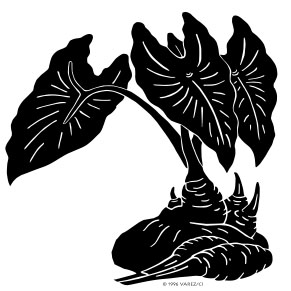 With his very able—and steady—hands, along with his empirical knowledge of the landscape and the stories, Dietrich set about making wood carvings and blocks, stuff he could give away. It was a lot of work with nothing to show for it. Carving blocks that he could print, and doing that out of linoleum, came forth as the practical solution. The first ones sold for $2 apiece at the store inside the national park.
With his very able—and steady—hands, along with his empirical knowledge of the landscape and the stories, Dietrich set about making wood carvings and blocks, stuff he could give away. It was a lot of work with nothing to show for it. Carving blocks that he could print, and doing that out of linoleum, came forth as the practical solution. The first ones sold for $2 apiece at the store inside the national park.
Dietrich’s now-iconic block prints are monochromatic, gorgeously composed, and intricately detailed. A distinctive style—in his own words, “strong, definite, there.” Each represents his conception of a narrative—a particular passage, a description of how Native Hawaiians related to nature, the wondrous feat of a god or goddess described in a legend. Some have delightfully patterned borders while others are solid-framed. Nothing is accidental.
As a process, each scene is first meticulously sketched out and then carefully carved with razor-sharp tools into the forgiving and relatively soft linoleum block. When the image is complete, the signature earth-brown paint is rolled onto the block and pressed onto rice paper. It used to be that Dietrich would sign every print: The title on the left, his name and year printed on the right.
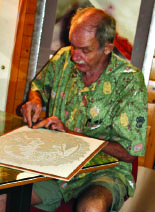
What he chooses to depict has evolved over the years. He’s bolder, more assertive. “I want to get people’s attention,” he declares. Not everything is flowery and sublime. “I want people to see the pig god’s eye, to get some spice in there, put in some risqué things, add a little bit of dare,” he adds. That spice and fire can be felt in his compositions, the flowing lines of paint, the focal point he makes you see.
His work is aligned with his personal style in ways. Dietrich has an earthy pragmatism and is a no-nonsense guy. When I told him I owned several of his prints he bellowed, “You have good taste!” “I do,” I replied, with an almost equal gusto.
A few years ago, he moved to a digital print process. These digital prints are not signed but are no less valuable than the ones that are because the image hasn’t changed. Dietrich is not an artist who believes in limited editions or exclusivity of any kind. He doesn’t bring his art to galleries that are going to mark up the price. He is everyman’s artist. “I want my work to be affordable and for everyone to have it, so Joe Six-Pack can buy a print if he wants one,” he explains. His most expensive prints cost $20.
He has been known to give prints away, too, even now. When I asked how that plays out, he replied, “They go into shock [that I am just giving it to them], and in the end they are happy that they have it and I am happy that they took it!”

His prints extend to a line of Reyn Spooner aloha shirts. Someone from the company asked him to design shirts. In Dietrich’s abiding, unpretentious way, he responded “Sure!” In exchange for providing designs, he gets boxes of shirts, and that suits him just fine.
The artist also paints. Unlike his monochromatic prints, the paintings are lush with color, swirling patterns, textural details, floral and flowing landscapes. He picked up painting from his wife, Linda, an accomplished and highly respected painter who, as he puts it, “showed me how to smear the paint on canvas.” When he’s tired of carving, he paints. It’s a change and “provides variety in the creative process and in the end process,” he notes.
Harnessing Circumstance
Perhaps the most life-changing decision Dietrich made was to purchase nine acres of land in Volcano, sight unseen, way back in 1969. He and Linda could barely afford rent on O‘ahu at the time, let alone buy a house, and the prospect of being able to own land and build on it proved to be irresistible. “I wanted my own place,” he said, simply. He built his home from the ground up, a solid wood structure deep in the bush in the Fern Forest/Glenwood area. Most people have never been there. He and his wife prefer it that way.
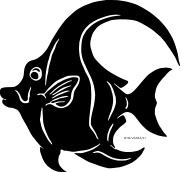 He learned to build from his seven years at Ala Wai Marina boatyard after his two-year stint at Fort Benning, Georgia, where he managed and recruited army staff. He left as a second lieutenant. Having no real boat-building skills, he learned from his expert coworkers about wood, tools, techniques, materials. It was great on-the-job training, and much more enjoyable than his previous work as a graduate teaching assistant. Boat-building brought him back to working with his hands.
He learned to build from his seven years at Ala Wai Marina boatyard after his two-year stint at Fort Benning, Georgia, where he managed and recruited army staff. He left as a second lieutenant. Having no real boat-building skills, he learned from his expert coworkers about wood, tools, techniques, materials. It was great on-the-job training, and much more enjoyable than his previous work as a graduate teaching assistant. Boat-building brought him back to working with his hands.
It’s noteworthy that his biological father, Friedrich Donat, served under Albert Speer as an architect and engineer in Germany during World War II. Dietrich recalls that his dad was always sketching at home. When Dietrich picked up a pencil, his dad made sure his lines were straight. “He was a pretty fussy old bastard,” Dietrich remembers. “A nasty architect is about as stiff as you can get,” he grins. Discipline with a pencil, it appears, never left the young boy.
Although his father fled from Berlin when the Russians invaded, Dietrich’s mother ended up meeting and marrying Manuel Varez, who adopted both Dietrich and his brother, Christian, and moved the family to O‘ahu in 1946. Dietrich (named for actress Marlene Dietrich who frequented his uncle’s coffee house in Germany) was only eight years old.
As a boy growing up at Fort Kamehameha at the mouth of Pearl Harbor, Dietrich preferred to spend time at home. He wasn’t particularly social and still isn’t. “I never liked parties or that stuff,” he says. “I’m not a social guy,” although he did work hard to fit in, learning pidgin and local ways, harnessing his new circumstances. He also figured out how to make things, like a go-kart. “I had it in me to put it all together.” As a teenager he was a hot-rodder, experimenting with cars and horsepower.
It wasn’t until he was in his 30s that he found a purpose for his life. The realization that many Hawaiian stories were not depicted visually proved to be his “aha.”

Looking back, it’s clear that his illustrations of Hawaiian stories and legends contributed to the renaissance of the Hawaiian culture. It was Dietrich Varez—the malihini (newcomer) from Germany—who was asked to illustrate Mary Kawena Pukui’s seminal collection of Hawaiian proverbs and wisdom, ‘Ōlelo No‘eau.
He doesn’t see Hawaiian culture through the lens of geography or indigenous peoples, per se. Rather, Dietrich sees a much bigger picture: the stories of humans and how they interpret life, develop community, cope with conflict in universal themes of man vs. man and man vs. nature. He just filters these themes through the Hawaiian culture, the people HERE, to illustrate the creation stories and bring home the mythology. In his books, like Hina, ‘Iwa, and Pele, Dietrich illuminates legends. Unlike conventional texts, he uses words only to explain pictures versus using pictures to illustrate text. His latest initiative goes even further—an adult coloring book, Pele, the Volcano Goddess, with 24 original block prints ready to come alive with colors you choose.
Pele serves as his muse and his work pays her homage in direct and indirect ways. He loves and finds quite fitting the fact that a wahine, Cindy Orlando, serves as Superintendent of Hawai‘i Volcanoes National Park. It is these women who have aligned with him all these years to make his life possible. “The National Park shaped me, formed me into what I am today. Hawai‘i took me in and gave me a home, hell, a whole life,” he reflects. “I want to repay that kindness in order to feel square.”
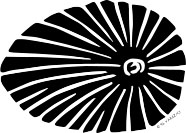 As for the Volcano Art Center, it wouldn’t be where it is today without its partnership with Dietrich Varez. Staffer Emily Weiss notes that Volcano Art Center Gallery has proudly represented Dietrich Varez and his artwork for over four decades. “His fine art prints and paintings express his deep understanding and appreciation of the Hawaiian culture. Volcano Art Center has been honored to share Hawai‘i’s unique customs, traditions and legends with visitors from around the world through his art,” Emily says.
As for the Volcano Art Center, it wouldn’t be where it is today without its partnership with Dietrich Varez. Staffer Emily Weiss notes that Volcano Art Center Gallery has proudly represented Dietrich Varez and his artwork for over four decades. “His fine art prints and paintings express his deep understanding and appreciation of the Hawaiian culture. Volcano Art Center has been honored to share Hawai‘i’s unique customs, traditions and legends with visitors from around the world through his art,” Emily says.
“Dietrich’s art, authentic and timeless, will be shared for generations,” Emily continues. “He is truly unique in his philosophy of art being easily accessible to all, [and] we believe this is an extension of the Aloha Spirit which Dietrich personifies. His spirit and Aloha will continue through the art he has created.”
Now 78, Dietrich seems comfortable with his legacy. “My work is all over the world,” he proclaims. “People from everywhere who have come to Hawai‘i have bought my prints”—very likely with his work at Hawai‘i Volcanoes National Park, which has been getting well over a million visitors in recent years. It’s like he’s been riding a wave that will never end, and that thought seems to bring him a sense of peace that perhaps he has, indeed, repaid the kindness. ❖
Where to purchase Dietrich Varez’s artwork
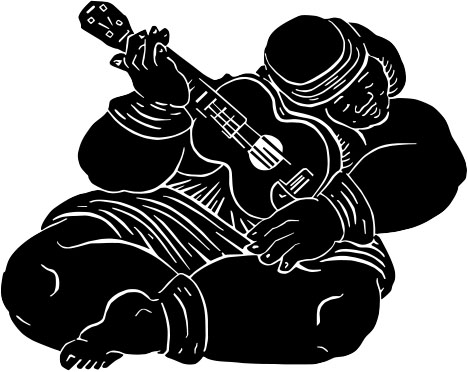 Hawai‘i Island:
Hawai‘i Island:
- Hawai‘i Volcanoes National Park
- Volcano Art Center Gallery
- Jaggar Museum Visitor’s Center
- Pu‘uhonua O Hōnaunau National Historic Park
- Pu‘ukoholā Heiau National Historic Site
Books available at Basically Books in Hilo
O‘ahu: Bishop Museum
Maui: Kīpahulu
Kaua‘i: Kōke‘e Museum
Contact writer Paula Thomas
Photos of Dietrich’s work and personal images courtesy of Karen Kaufman, ArtPrintsHawaii.com
Images from Basically Books courtesy of Christine Reed
